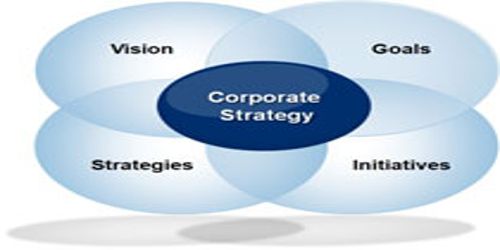Corporate strategy encompasses a firm’s corporate actions with the aim to achieve company objectives while achieving a competitive advantage. It is the direction an organization takes with the objective of achieving business success in the long term. Recent approaches have focused on the need for companies to adapt to and anticipate changes in the business environment, i.e. a flexible strategy. The development of a corporate strategy involves establishing the purpose and scope of the organization’s activities and the nature of the business it is in, taking the environment in which it operates, its position in the marketplace, and the competition it faces into consideration; most times analyzed through a SWOT analysis.

Nature of corporate strategy
Corporate strategy is supposed to be the means by which an organization achieves and sustains success. Yet, it rarely rises to that level, despite an abundance of corporate strategy theory and significant research from many organizations over the past few decades. The changes over the years are considered in the form of small, theoretical refinements, rather than large and significant steps required for further management transition
The original meaning of the word strategy derives from the Geek strategia, which is used in the military terms and represents the ability to employ available resources to win a war. This interpretation has generated problems when such concept is used in a business context because it implies the existence, even the necessity, of opponents. As a result, most managers believed that a corporate strategy implies a strong focus on competition, since competition takes place almost exclusively at the offering level; most organizations concentrate their strategic efforts on constantly improving the goods and services they offer. This overemphasis on the temporary success, however, can often obscure the kind of thinking and emphasis that would lead to sustained success, even a continuous repetition of temporary successes doesn’t equate to sustainable strategy. In an effort to increase the value of single offerings, the organisation may be distracted from larger questions of structure, mission and objective (Papers4you.com, 2006).
In war, objectives can often be clearly defined, and so strategy is thought of as a means to a specific end. This view has persisted in the corporate world where strategies are conceived as plans to accomplish specific goals. Although corporate strategy can be very goal-oriented, especially in the early stages of a company’s development, the very nature of goals implies temporary success. By contrast, sustainable success is not, and cannot be an end unto itself or a goal to achieve. Therefore, goal orientation becomes arguably inappropriate when success has to be indefinitely sustained.
Despite this, an overwhelming number of top executives and researchers make extensive use of objectives in their quest of lasting corporate success. Certainly, a number of factors contribute to this: the need of leaders with limited tenure to point to achievements, the tyranny of meeting the expectations of the financial markets and most management teams extensively rely on forecasting and planning. Still, the idea held by most managers that strategy itself is all about goal achievement only exacerbates the situation. Therefore, it is important for strategists to remember that the more specific an objective, the further away it may potentially lead the organisation from its optimal big picture.
So how strategy should be redefined? Clearly it cannot rely too strongly on objectives nor can it focus too heavily on competition. A more fundamental concept is needed to guide an organisation in seeing its big picture, and such concept should be customer. To create sustainable, long-term success, an organisation must first and fundamentally understand and relate to its customers. It is the ongoing encouragement of this understanding, based on neither specific competitors nor temporal objectives, which must be at the heart of any real strategy. And it is that from which all objectives should naturally flow.
Example
Corporate strategies may pertain to different aspects of a firm, yet the strategies that most organizations use are cost leadership and product differentiation.
Cost leadership is a strategy that organizations implement by providing their products and services as low as consumers are willing to pay, thereby being competitive and realizing a volume of sales that allows them to be the leaders in the industry. Typical examples of cost leaders are Wal-Mart in the retail industry, McDonalds in the restaurant industry, and Ikea, the furniture retailer that offers low-priced, yet good quality home equipment by sourcing its products in emerging markets, thereby having a high-profit margin.
Other examples of corporate strategies include the horizontal integration, the vertical integration, and the global product strategy, i.e. when multinational companies sell a homogenous product around the globe.
Corporate strategies are always growth-oriented, seeking to retain a company’s existing customer base while attracting new customers.
Information Source
















